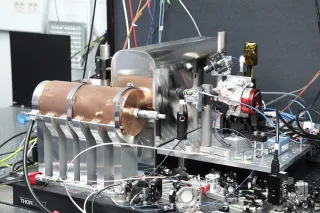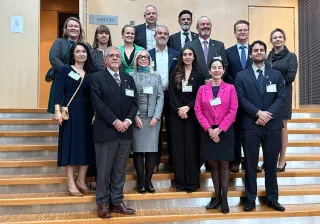Measurement data is present in our daily lives in many different ways. We acquire plenty of data on climate change, but the data is only reliable if the instruments are calibrated regularly. Safe operation of nuclear power plants is only possible if critical measuring instruments are checked frequently. The statutory checks of scales in grocery stores ensure that vegetables will cost exactly what the stores promise. Measuring instruments are calibrated by comparing them with a reference device under controlled conditions. To do this, the devices are brought to the same physical location. The digital leap during the COVID-19 pandemic has made many physical meetings virtual: Could the same happen to calibrations? Could calibrations be done virtually in the digital age?
Since 2019, measurements in the SI system of units have been based on seven defining constants, which are defined by the laws of physics and always have the same numerical value everywhere. In principle, this provides us with the most accurate possible references for calibrations anywhere. If the SI system could be stored in a very small space, it could be integrated into routinely used measurement devices.
In fact, several currently ongoing research projects around the world aim to produce microchips with sensors that operate directly based on the definitions of the units of measurement. However, even if such sensors become widely used in different measuring instruments, the operating principle alone does not ensure the quality of the data obtained from these instruments, nor does it provide the user with valuable information about the uncertainty of measurement. The overall design, aging, and application method of a measurement system as well as the operating environment have a large impact on the reliability of measurement results.
In international trade and industrial activities, measurement results must have proven traceability to the SI system. Periodically made calibrations play an important role in this. Thus, even in the digital age, calibrations will remain necessary, but the ways of making them will change.
The benefits and challenges of digitalisation in the field of calibration
Evidently, technological development will have two apparent benefits for users and operators of measuring devices in the future. As individual measuring instruments are replaced with sensor networks and systems that utilise many types of measurement data, calibrations do not have to be made as often and they can be better adapted to other activities. This is made possible by intelligent operation diagnostics built into the systems.
On the other hand, digital systems enable faster and more efficient processing and transfer of calibration data between different actors. Automation makes quality assurance more cost-effective and reduces the need for human resources.
While companies that carry out calibration activities receive these same benefits, technological developments also cause challenges for them. The most significant of these are:
- devices with multiple types of sensors
- systems that produce measurement data through simulations based on signals from individual sensors
- smart measuring devices based on constantly learning algorithms.
How can we calibrate such devices so that the calibration results, along with their measurement uncertainty, are applicable during normal operation? It is no longer enough to make measurements with the sensor and the reference device in the same location under static conditions. In the future, calibration will include various functional and simulation-based tests that can be used to demonstrate the reliability of the data produced by the measuring instrument, even when changes in the measured object are rapid, when the instrument's own diagnostics change their calculation algorithm or adjustment parameters, and when the measuring conditions change significantly. Calibration procedures may also be optimised by using different calibration methods at different times.
Since sufficient coverage of the calibration in relation to the application is very important, scientifically researched information on the operation of the measuring instruments is needed to determine the minimum requirements. On the other hand, sufficient consensus is needed on how these characteristics are expressed in calibration data and transmitted in a digital format.
"Digital SI" aims for reliable processing of measurement data
The metrology community, based on international agreements, has introduced the term "Digital SI". Despite its name, "Digital SI" does not attempt to make the entire SI system of units digital. Instead, its goal is to create a uniform way of processing measurement and calibration data made in SI units and transferring them within digital systems. This is important for avoiding misinterpretation of results and for ensuring efficient automated transfer of calibration results worldwide. "Digital SI" is being developed in many different projects around the world. In Finland, it is being developed through cooperation between VTT MIKES and several companies.
Digitalisation is thus changing the field of calibration, even if calibration is not becoming completely virtual. The reliability of the measurements will continue to be based on the physical world around us. Some calibrations are already made with remotely operated devices, but the calibration measurements themselves are still made in the same physical place and conditions with the calibrated instruments. Fully virtual calibration is only suitable for the virtual world.





